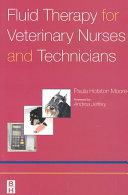Fluid Therapy for Veterinary Nurses and Technicians, 1st Edition

This book covers the NVQ Level III Part 2 syllabus making it an essential purchase for second year veterinary nursing students, however, will also be useful for veterinary nurses in practice. Practical tips are a feature of the book and topics covered include: different types of fluid therapy equipment, assessment of fluid balance and administration of fluid therapy.
Autor: Paula Jane Hotston Moore, MEd, RVN
| Nakladatel | Elsevier Saunders |
|---|---|
| ISBN | 9780750652834 |
| Vydání | 2003 |
| Vazba | brožovaná |
| Počet stran | 120 |
Key Features
Covers everything the veterinary nurse or technician needs to know about fluid therapy and how to apply theory to practice.
Serves as a practical manual that explains this difficult subject in an accessible and easy-to-understand approach at an appropriate level.
Improves the reader's skills with "In Practice" tips for effective fluid administration.
Covers the NVQ Level III Part 2 syllabus, making it an essential purchase for second year veterinary nursing students as well as veterinary nurses in practice.
Author Information
By Paula Jane Hotston Moore, MEd, RVN, Internal Verifier and Tutor, University of Bristol, Bristol, UK
1. Water and electrolyte balance in the body: Definition of key terms;
Fluid distribution within the body compartments;
Electrolyte balance in body fluid;
Water balance and its importance;
Ways in which fluid is lost from the body;
Ways in which fluid is taken into the body;
Normal fluid requirements;
2. Assessment of fluid balance: Definition of key terms;
Causes of dehydration;
Causes of hypovolaemia;
Clinical signs of dehydration;
Ways of assessing dehydration and hypovolaemia;
3. Acid base balance: Significance of acid base balance to the animal;
How the body maintains its pH;
How changes to the body’s pH arise;
Causes of metabolic acidosis/alkalosis and respiratory acidosis/alkalosis;
4. Types of fluid available: List of fluids available in the UK;
List of constituents in each fluid;
How fluids differ from each other and why this is significant;
5. Blood administration: When administration of blood is indicated;
Blood collection;
Blood typing;
Storage of blood;
Blood volume;
Blood transfusions;
Plasma/blood products;
6. When to use each fluid: Shock – definition and types of shock;
Common conditions and when to use each fluid – and why;
7. Administration of fluid therapy: Routes available for fluid therapy administration; Common routes of intravenous fluid therapy – veins and anatomical locations; Intravenous catheter placement;
8. Equipment available for administration of intravenous fluid therapy: Describe equipment, how and when it is used;
9. Calculations and Flow rates: Explanation of calculations;
Worked example; How to calculate the amount of fluid to give and the rate of flow;
10. Monitoring the Patient: Central venous pressure;
Clinical signs of over transfusion;
Blood transfusion reactions;
General care of patient whilst receiving intravenous fluid therapy;
Care of intravenous catheters;
Prevention of patient interference;
Common problems;
11. Other species (e.g. rabbits, reptiles, calves, etc): Clinical situations when fluid therapy is indicated;
How to administer fluid therapy in species other than cat or dog;
Different equipment required